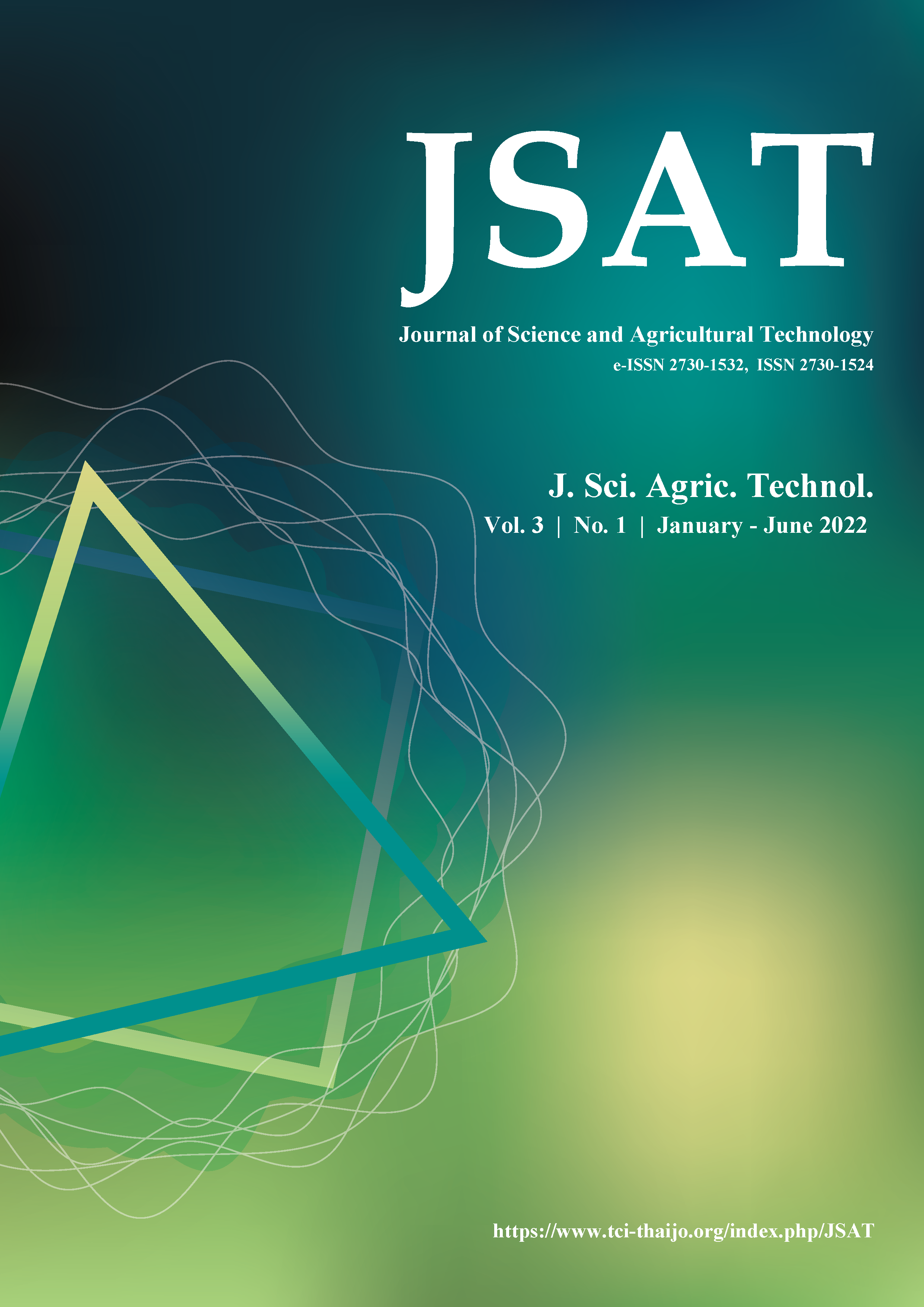Effects of leonardite and nutrient management on growth and yield of cowpea (Vigna unguiculata L. Walp.)
Main Article Content
Abstract
A study on the effects of leonardite and nutrient management on growth and yield of cowpea (Vigna unguiculata L. Walp.) was established in the greenhouse from July to October 2021 at the Agricultural Technology Research Institute, Rajamangala University of Technology Lanna, Lampang, Thailand. The experimental design was a completely randomized design (CRD) with nine treatments and ten replications: (1) control, (2) 500 kg/rai leonardite, (3) 1,000 kg/rai leonardite, (4) 500 kg/rai leonardite + 100% chemical fertilizer based on soil analysis, (5) 1,000 kg/rai leonardite + 100% chemical fertilizer based on soil analysis, (6) 500 kg/rai leonardite + 75% chemical fertilizer based on soil analysis, (7) 1,000 kg/rai leonardite + 75% chemical fertilizer based on soil analysis, (8) 100% chemical fertilizer based on soil analysis and (9) 75% chemical fertilizer based on soil analysis. The result showed that the combination of leonardite with chemical fertilizers based on soil analysis affected the vegetative growth and yield of cowpea. The application of 500 kg/rai of leonardite in combination with 100% chemical fertilizer based on soil analysis gave the highest plant height, canopy width, stem diameter, leaf width, leaf length, leaf greenness (SPAD), fresh weight, and dry weight of pod per plant. Therefore, applying leonardite with chemical fertilizers based on soil analysis could enhance cowpea growth and yield.
Article Details

This work is licensed under a Creative Commons Attribution-NonCommercial-NoDerivatives 4.0 International License.
References
Benchasri, S., Domyos, S., and Pruthikanee, P. 2014. Potential of yardlong bean production under chemical and organic system in Southern Thailand. Thaksin University, Thailand.
Department of Agricultural Extension. 2019. Cultivation situation of cowpea: 2018-2019. Ministry of Agriculture and Cooperatives, Thailand.
Department of Land Development. 2015. State of soil and land resources of Thailand. The Agricultural Cooperative Federation of Thailand, Thailand.
Enyiukwu, DN., Amadioha, AC., and Ononuju, CC. 2018. Nutritional significance of cowpea leaves for human consumption. Greener Trend in Food Science and Nutrition. 1(1): 1-10.
Faculty of the Department of Soil Science. 2006. Introduction to soil science. Kasetsart University Press, Thailand.
Goncalves, A., Goufo, P., Barros, A., Dominguez-Perles, R., Trindade, H., Rosa. E A S., Ferreira, L., and Rodrigues, M. 2016. Cowpea (Vigna unguiculata L. Walp), a renewed multipurpose crop for a more sustainable agri-food system: nutritional advantages and constraints. Journal of the Science of Food and Agriculture. 96: 2941-2951.
Jayathilake, C., Visvanathan, R., Deen, A., Bangamuwang, R., Jayawardana B.C., Nammi, S., and Liyanage, R. 2018. Cowpea: an overview on its nutritional facts and health benefits. Jounal of the Science of Food and Agriculture. 98(13): 4793-4806.
Khan, A.R., Alam, S., Ali, S., Bibi, S., and Khalil I.A. 2007. Dietary fiber profile of food legumes. Sarhad Journal of Agriculture. 23(3): 763 766.
Landrot, S., Armartmontree, C., Khongkaew, C., and Jutamanee, K. 2020. Leonardite-based organic fertilizer production complying with the organic fertilizer standard of the department of agriculture. King Mongkut’s Agricultural Journal. 38(1): 93-103.
Ngennoy, S., Jutamanee, K., Rungmekarat, S., and Kaokaew, S. 2014. Effect of humic substance and chemical fertilizer application on plant nutrient, growth and yield of maize (Zea mays L.). Proceedings of 52nd Kasetsart University Annual Conference: Plant, 4-7 Feb 2014. Kasetsart University, Bangkok. p.252-259.
Pochadom, S., Khaokaew, S., Sooksamiti, P., Jutamanee, K., and Landrot, G. 2013. Chemical characterizations of leonardite from lignite mine for agricultural application. Proceedings of 51st Kasetsart University Annual Conference: Plant. Kasetsart University, Bangkok. p.243-249.
Pompranee, P. 2017. Soil science. Faculty of Science and Technology, Nakhon Pathom Rajabhat University. Ratanaprommanee, C., Chinachanta, K., Chaiwan, F., and Shutsrirung, A. 2016. Chemical characterization of leonardite and its potential use as soil conditioner and plant growth enhancement. Asia-Pacific Journal of Science and Technology. 22(4): 1-10.
Rinnarong, S., Chittaladakorn, A., and Thienhirun, P. 2016. Effect of leonardite on growth and yield of Chinese cabbage (Brassica campestris var.chinensis). The 6th STOU National Research Conference. P.1-13.
Rittirat, A. 2017. Study of the use of the coal power plant byproduct (Leonardite) to adsorb. Master Degree of Environmental Engineering, Suranaree University of Technology, Thailand.
Sanli, A., Karadogan, T., and Tonguc, M. 2013. Effects of leonardite applications on yield and some quality parameters of potatoes (Solanum tuberosum L.). Turkish Journal of Field Crops. 18(1): 20-26.
Sariyildiz, T. 2020. Effects of leonardite and mineral fertilizer applications on plant growth and soil quality of garlic (Allium sativum L.). Turkish Journal of Agriculture-Food Science and Technology. 8(8): 1763-1772.
Totirakul, V., Sooksamiti, P., and Tokamolthom, J. 2009. The potential of the leonardite from lignite Mae Mho mine Lampang province for preparation of humic acids and humic salts. The Office of Primary Industries and Mines Region 3, Ministry of Industry, Thailand.


